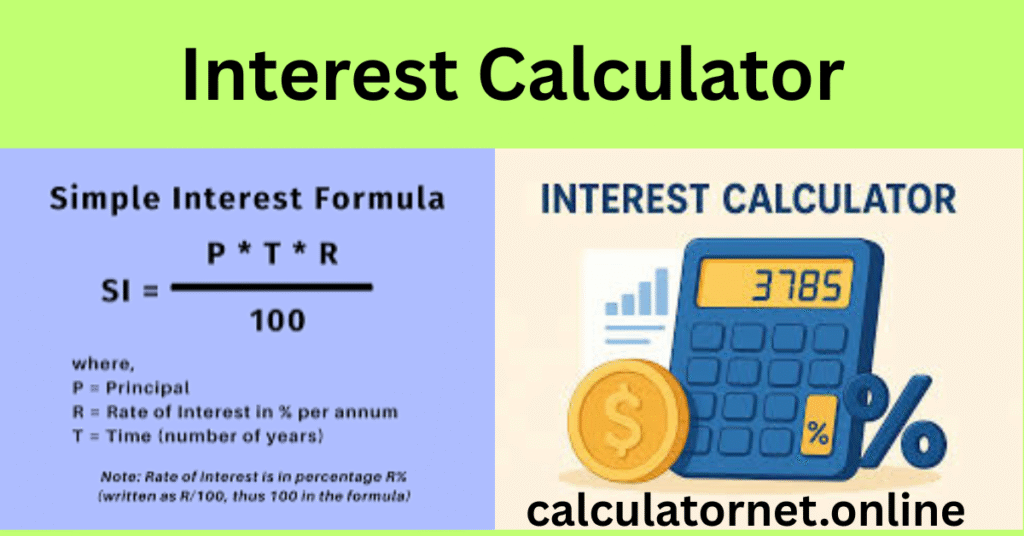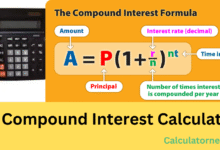Interest Calculator

Contents
- 1 Interest Calculator
- 2 Interest Calculator: Your Ultimate Guide to Financial Growth
Interest Calculator
Support the Developer
Bank Details
- Name: Majid Farooq
- Bank: Habib Bank Limited
- Account Number/IBAN: PK40HABB0001947100292703
- Country: Pakistan
Interest Calculator: Your Ultimate Guide to Financial Growth
If you’ve ever wondered how your savings account balance seems to grow on its own or how loan interest can add up so quickly, you’ve encountered the powerful concept of interest. Understanding how interest works is the first step toward making smarter financial decisions, whether you’re saving for a home, planning for retirement, or just trying to get a handle on your debt. This guide will demystify the two main types of interest—simple and compound—and show you why the latter is a game-changer for building wealth. We’ll also cover other important factors like inflation and taxes, all while showing you how an interest calculator can be your best friend in planning your financial future.
Simple vs. Compound Interest: What’s the Difference?
When you first hear the word “interest,” you’re probably thinking about the cost of borrowing money or the reward for lending it. While that’s true, there are two distinct ways it’s calculated.
Simple Interest
Simple interest is the most straightforward method. It’s calculated only on the original amount you borrow or invest, known as the principal. For example, if you lend someone $100 at a 10% simple interest rate for two years, you’ll earn $10 each year, for a total of $20. The formula is easy:
- Interest = Principal × Rate × Time
This method is rarely used in modern finance, but it’s a great starting point for understanding the basic concept.
Compound Interest
This is where things get interesting. Compound interest is calculated on the principal and any accumulated interest from previous periods. This “interest on interest” is what makes it so powerful. Think back to the $100 loan at a 10% rate. After the first year, you’d have $110. In the second year, the 10% interest is calculated on the new $110 balance, earning you $11 instead of $10. Your total return is now $21, one dollar more than with simple interest.
The more frequently interest is compounded (monthly, daily, or even continuously), the faster your money grows. Over time, the difference between simple and compound interest becomes massive, illustrating why it’s a cornerstone of long-term investing.
The Power of Contributions and the Rule of 72
A key feature of many interest calculators is the ability to factor in regular contributions. Making periodic deposits to your savings or investment account, even small ones, can dramatically accelerate your financial growth. For example, contributing an extra $50 a month can add up to thousands of dollars in extra interest over a decade.
A simple mental shortcut for understanding the power of compounding is the Rule of 72. This rule helps you estimate how long it will take for your investment to double. Simply divide 72 by the annual interest rate. For instance, if you have an 8% interest rate, it will take roughly 9 years (72 ÷ 8) for your money to double. This works best for rates between 6% and 10% but provides a quick, useful estimate.
Important Factors: Tax and Inflation
While an interest calculator can give you a clear picture of your potential growth, it’s crucial to consider two major external factors: taxes and inflation.
- Tax Rate: The government often takes a cut of your interest income. For example, if you earn $100 in interest and have a 25% tax rate, you’ll only get to keep $75. This can significantly reduce your real returns, so it’s important to factor it in.
- Inflation Rate: Inflation is the gradual increase in prices over time, which reduces the purchasing power of your money. If your investment earns a 5% interest rate but inflation is 3%, your real rate of return is only 2%. This means the buying power of your money isn’t growing as fast as the numbers on your statement might suggest.
Factoring in both your tax and inflation rates will give you the most accurate picture of your financial growth.
The Interest Calculator: Your Financial Co-Pilot
Using an interest calculator is one of the easiest and most effective ways to visualize your financial journey. It allows you to experiment with different scenarios:
- How would adding a monthly contribution change your final balance?
- What’s the impact of a higher interest rate on your long-term wealth?
- How do taxes and inflation affect your buying power over time?
By plugging in different numbers, you can see the real-world impact of your financial decisions and create a clear roadmap toward your goals.
Frequently Asked Questions
Q: What is the main difference between simple and compound interest?
A: Simple interest is calculated only on the original principal amount. Compound interest, on the other hand, is calculated on both the principal and any accumulated interest, causing your money to grow at an accelerating rate over time.
Q: How does inflation affect my savings?
A: Inflation reduces the purchasing power of your money over time. If your savings interest rate is lower than the inflation rate, the real value of your money is actually decreasing, even though the nominal balance is growing.
Q: Can a high-yield savings account beat inflation?
A: A high-yield savings account can help combat inflation by offering a higher interest rate than traditional accounts. However, you should always compare the interest rate to the current inflation rate to see if your money’s buying power is truly growing.
Q: What is the Rule of 72 and how is it used?
A: The Rule of 72 is a mental shortcut to estimate how long it will take for an investment to double. You simply divide 72 by the annual interest rate. For example, at an 8% interest rate, it would take approximately 9 years to double your money.
Q: Are all types of interest income taxable?
A: In many countries, interest income from sources like savings accounts, bonds, and CDs is subject to taxes. However, some types of interest, like that from municipal bonds, may be exempt from state and local taxes.
Q: Is it better to contribute at the beginning or end of a compounding period?
A: Making a contribution at the beginning of a compounding period is generally better. This allows your money to start earning interest immediately, giving it more time to grow and compound.
Q: How does the compounding frequency affect my returns?
A: The more frequently interest is compounded (e.g., daily vs. annually), the higher the total return will be. This is because your interest starts earning its own interest sooner.
Conclusion
Understanding interest is a fundamental part of financial literacy. While simple interest provides a basic framework, it’s the power of compound interest that truly drives long-term wealth accumulation. By using an interest calculator and accounting for crucial factors like taxes and inflation, you can create a realistic and powerful financial plan. The sooner you start leveraging the magic of compounding, the more your money can work for you.
Have you used an interest calculator before? What’s the biggest insight you’ve gained from it? Share your thoughts in the comments below!







